Evaluation of Design Parameters for Daylighting Performance in Secondary School Classrooms Based on Field Measurements and Physical Simulations: A Case Study of Secondary School Classrooms in Guangzhou
Abstract
:1. Introduction
2. Methodology
2.1. Basic Information
2.2. Workflow
2.2.1. Modeling
2.2.2. Daylighting Performance Simulation
2.2.3. Testing Tools and Methods
2.2.4. Multi-Objective Optimization Design
3. Results
3.1. Simulated Daylighting Performance
3.1.1. Simulated DF Distribution
3.1.2. Simulated PIT
3.1.3. Simulated DGP
3.1.4. Simulated Lighting Energy Consumption
3.2. Classroom Daylighting Performance Measurement
3.2.1. Classroom Illuminance Field Measurement
3.2.2. Luminance Measurement
3.2.3. Lighting Energy Consumption Monitoring
3.3. Multi-Objective Optimization Design
4. Discussion
4.1. Evaluating Design Parameters by Measured vs. Simulated Daylighting Performance Index
4.2. Accuracy of Physical Simulations and Field Measurements
4.3. Advantages and Disadvantages of Genetic Algorithms
4.4. Data-Driven Performance Prediction
5. Conclusions
- (1)
- Small variations in the window transmittance coefficient exerted a significant impact on the simulation results. A reduction of 0.1 in the transmittance coefficient resulted in a 10.1% decrease in the average PIT and a 14.6% decrease in the average DF. A further reduction of 0.2 in the coefficient led to a 40.4% decrease in the average PIT and a 32.6% decrease in the average DF.
- (2)
- In accordance with established architectural design standards, four design parameter ranges that impact classroom daylighting performance were delineated: orientation within 27°30′ to 28°44′ south of west, total window width of 8.5 m to 8.8 m on the main daylighting facade, window height of 2.32 m to 2.4 m, sunshade overhang width of 1.85 m to 1.94 m, and window transmittance coefficient of 0.87 to 0.9.
- (3)
- Compared to Classroom A, which exhibited better daylighting conditions than other classrooms included in the case study, the daylighting performance obtained by using the recommended parameters can effectively reduce the indoor DGP, increase the average PIT by 41.4%, increase the average DF by 41.3%, and decrease the energy consumed by artificial lighting by up to 10.9%.
Author Contributions
Funding
Data Availability Statement
Conflicts of Interest
Nomenclature
| DGP | Daylight glare probability |
| PIT | Point-in-time illuminance |
| DF | Daylight factor |
| GAs | Genetic algorithms |
| WWR | Window-to-wall ratio |
| DA | Daylight autonomy |
| sDA | Spatial daylight autonomy |
| UDI | Useful daylight illuminance |
| CBDM | Climate-based daylight modeling |
| IESNA | Illuminating Engineering Society of North America |
| E | Illuminance |
| Eavg | Average illuminance |
| En | Indoor illuminance |
| Ew | Outdoor illuminance |
| ρ | Reflectance coefficient |
| Eρ | Reflected illuminance |
| τ | Transmittance coefficient |
| Eτ | Transmitted illuminance |
| Eυ | Vertical illuminance |
| Lruanj | Luminance |
| ω | Solid angle |
| P | Position index |
Appendix A
| DGP Classification | DGP Range |
| Imperceptible Glare | 0.35 > DGP |
| Perceptible Glare | 0.4 > DGP ≥ 0.35 |
| Disturbing Glare | 0.45 > DGP ≥ 0.4 |
| Intolerable Glare | DGP ≥ 0.45 |
References
- Mendell, M.J.; Heath, G.A. Do indoor pollutants and thermal conditions in schools influence student performance? A critical review of the literature. Indoor Air 2005, 15, 27–52. [Google Scholar] [CrossRef] [PubMed]
- Shen, J.Y.; Kojima, S.; Ying, X.Y.; Hu, X.J. Influence of Thermal Experience on Thermal Comfort in Naturally Conditioned University Classrooms. Lowl. Technol. Int. 2019, 21, 107–122. [Google Scholar]
- Ramírez-Dolores, C.; Lugo-Ramírez, L.A.; Hernández-Cortaza, B.A.; Alcalá, G.; Lara-Valdés, J.; Andaverde, J. Dataset on thermal comfort, perceived stress, and anxiety in university students under confinement due to COVID-19 in a hot and humid region of Mexico. Data Brief 2022, 41, 107996. [Google Scholar] [CrossRef] [PubMed]
- Lovec, V.; Premrov, M.; Leskovar, V.Ž. Practical impact of the COVID-19 pandemic on indoor air quality and thermal comfort in kindergartens. A case study of Slovenia. Int. J. Environ. Res. Public Health 2021, 18, 9712. [Google Scholar] [CrossRef] [PubMed]
- Luo, W.; Kramer, R.; Kompier, M.; Smolders, K.; de Kort, Y.; Lichtenbelt, W.V.M. Effects of correlated color temperature of light on thermal comfort, thermos physiology and cognitive performance. Build. Environ. 2023, 231, 109944. [Google Scholar] [CrossRef]
- Castilla, N.; Higuera-Trujillo, J.L.; Llinares, C. The effects of illuminance on students′ memory. A neuroarchitecture study. Build. Environ. 2023, 228, 109833. [Google Scholar] [CrossRef]
- Al Junaibi, A.A.; Al Zaabi, E.J.; Nassif, R.; Mushtaha, E. Daylighting in Educational Buildings: Its Effects on Students and How to Maximize Its Performance in the Architectural Engineering Department of the University of Sharjah. In Proceedings of the 3rd International Sustainable Buildings Symposium (ISBS 2017), Dubai, United Arab Emirates, 15–17 March 2017; Springer International Publishing: Cham, Switzerland, 2018; Volume 1, pp. 141–159. [Google Scholar]
- Choi, S.; Guerin, D.; Kim, H.-Y.; Brigham, J.K.; Bauer, T. Indoor Environmental Quality of Classrooms and Student Outcomes: A Path Analysis Approach. J. Learn. Spaces 2014, 2, 14. [Google Scholar]
- Dahlan, A.S.; Eissa, M.A. The Impact of Day Lighting in Classrooms on Students’ Performance. Int. J. Soft Comput. Eng. 2015, 6, 2231–2307. [Google Scholar]
- Fielding, R. Learning, Lighting and Color: Lighting Design for Schools and Universities in the 21st Century; DesignShare (NJ1): Minneapolis, MN, USA, 2006. [Google Scholar]
- Huaxia Ophthalmology. White Paper on National Prevention and Control of Myopia Among Children and Adolescents; Huaxia Ophthalmology: Xiamen, China, 2021. [Google Scholar]
- Guo, Y.; Liu, L.J.; Xu, L.; Tang, P.; Lv, Y.Y.; Feng, Y.; Meng, M.; Jonas, J.B. Myopic shift and outdoor activity among primary school children: One-year follow-up study in Beijing. PLoS ONE 2013, 8, e75260. [Google Scholar] [CrossRef]
- Zhao, T.; Zhang, C.; Xu, J.; Wu, Y.; Ma, L. Data-driven correlation model between human behavior and energy consumption for college teaching buildings in cold regions of China. J. Build. Eng. 2021, 38, 102093. [Google Scholar] [CrossRef]
- Wu, Y.; Li, Y.; Gao, S.; Liu, S.; Yin, H.; Zhai, Y. Carbon dioxide generation rates for children and adolescents. Build. Environ. 2023, 237, 110310. [Google Scholar] [CrossRef]
- Ministry of Education of the People’s Republic of China. Statistical Bulletin on Education Development in 2021; Ministry of Education of the People’s Republic of China: Beijing, China, 2022. [Google Scholar]
- Tsinghua University Building Energy Research Center. China Building Energy Annual Development Research Report 2022: Public Building Special Topic; China Architecture & Building Press: Beijing, China, 2022; p. 160. ISBN 9787112271948. [Google Scholar]
- Rose, K.A. Time spent outdoors can prevent the development of myopia. Acta Ophthalmol. 2008, 86. [Google Scholar] [CrossRef]
- He, M.; Xiang, F.; Zeng, Y.; Mai, J.; Chen, Q.; Zhang, J.; Smith, W.; Rose, K.; Morgan, I.G. Effect of Time Spent Outdoors at School on the Development of Myopia among Children in China: A Randomized Clinical Trial. J. Am. Med. Assoc. 2015, 314, 1142–1148. [Google Scholar] [CrossRef]
- GB 7793-2010; Hygienic Standard for Day Lighting and Artificial Lighting for Middle and Elementary School. China Standards Press: Beijing, China, 2010; p. 2, ISBN 155066141915.
- Rashwan, A.; El Gizawi, L.; Sheta, S. Evaluation of the effect of integrating building envelopes with parametric patterns on daylighting performance in office spaces in hot-dry climate. Alex. Eng. J. 2019, 58, 551–557. [Google Scholar] [CrossRef]
- Liu, Q.; Han, X.; Yan, Y.; Ren, J. A Parametric Design Method for the Lighting Environment of a Library Building Based on Building Performance Evaluation. Energies 2023, 16, 832. [Google Scholar] [CrossRef]
- Eisazadeh, N.; Allacker, K.; De Troyer, F. Integrated energy, daylighting and visual comfort analysis of window systems in patient rooms. Sci. Technol. Built Environ. 2021, 27, 1040–1055. [Google Scholar] [CrossRef]
- Norouziasl, S.; Jafari, A. Exploring Human-Building Energy-Related Actions Modeling and Simulation. Constr. Res. Congr. 2022, 2022, 1316–1326. [Google Scholar]
- Kapp, S.; Choi, J.K.; Hong, T. Predicting industrial building energy consumption with statistical and machine-learning models informed by physical system parameters. Renew. Sustain. Energy Rev. 2023, 172, 113045. [Google Scholar] [CrossRef]
- Lei, L.; Chen, W.; Wu, B.; Chen, C.; Liu, W. A building energy consumption prediction model based on rough set theory and deep learning algorithms. Energy Build. 2021, 240, 110886. [Google Scholar] [CrossRef]
- Krarti, M.; Erickson, P.M.; Hillman, T.C. A simplified method to estimate energy savings of artificial lighting use from daylighting. Build. Environ. 2005, 40, 747–754. [Google Scholar] [CrossRef]
- Lin, B.; Li, Z. Energy-saving optimization method for building design at the early stage. Chin. Sci. Bull. 2016, 61, 113–121. [Google Scholar] [CrossRef]
- Reinhart, C.F.; Mardaljevic, J.; Rogers, Z. Dynamic daylight performance metrics for sustainable building design. Leukos 2006, 3, 7–31. [Google Scholar] [CrossRef]
- Brembilla, E.; Mardaljevic, J. Climate-Based Daylight Modelling for compliance verification: Benchmarking multiple state-of-the-art methods. Build. Environ. 2019, 158, 151–164. [Google Scholar] [CrossRef]
- Besbas, S.; Nocera, F.; Zemmouri, N.; Khadraoui, M.A.; Besbas, A. Parametric-Based Multi-Objective Optimization Workflow: Daylight and Energy Performance Study of Hospital Building in Algeria. Sustainability 2022, 14, 12652. [Google Scholar] [CrossRef]
- Amasyali, K.; El-Gohary, N. Building lighting energy consumption prediction for supporting energy data analytics. Procedia Eng. 2016, 145, 511–517. [Google Scholar] [CrossRef]
- Li, X.; Wen, J. Review of building energy modeling for control and operation. Renew. Sustain. Energy Rev. 2014, 37, 517–537. [Google Scholar] [CrossRef]
- Norouziasl, S.; Jafari, A. Identifying the most influential parameters in predicting lighting energy consumption in office buildings using data-driven method. J. Build. Eng. 2023, 72, 106590. [Google Scholar] [CrossRef]
- Yun, G.; Kim, K.S. An empirical validation of lighting energy consumption using the integrated simulation method. Energy Build. 2013, 57, 144–154. [Google Scholar] [CrossRef]
- Amasyali, K.; El-Gohary, N.M. A review of data-driven building energy consumption prediction studies. Renew. Sustain. Energy Rev. 2018, 81, 1192–1205. [Google Scholar] [CrossRef]
- Fan, C.; Xiao, F.; Wang, S. Development of prediction models for next-day building energy consumption and peak power demand using data mining techniques. Appl. Energy 2014, 127, 1–10. [Google Scholar] [CrossRef]
- FEMP. M&V Guidelines: Measurement and Verification for Federal Energy Projects Version 3.0; Energy Efficiency and Renewable Energy: Washington, DC, USA, 2008. [Google Scholar]
- GB50033-2013; Standard for Daylighting Design of Buildings. Ministry of Housing and Urban-Rural Development of the People’s Republic of China. China Architecture & Building Press: Beijing, China, 2013; p. 8, ISBN 1511223678.
- China Meteorological Data Network. Monthly Standard Values of Ground Climate in China (1981–2010); China Meteorological Administration Meteorological Data Center: Beijing, China, 2011. [Google Scholar]
- GB55016-2021; General Code for the Built Environment. China Architecture & Building Press: Beijing, China, 2021; pp. 6–7, ISBN 1151238205.
- Raynham, P. Book review: The lighting handbook 10th edition, reference and application. Light. Res. Technol. 2012, 44, 514–515. [Google Scholar] [CrossRef]
- Brembilla, E.; Drosou, N.; Mardaljevic, J. Real World Complexity in Reflectance Value Measurement for Climate-Based Daylight Modelling. In Proceedings of the Building Simulation and Optimization Conference (BSO16), Newcastle upon Tyne, UK, 12–14 September 2016; Newcastle University: Newcastle upon Tyne, UK, 2016; pp. 266–273. Available online: https://www.semanticscholar.org/paper/Real-world-complexity-in-reflectance-value-for-Brembilla-Drosou/62804d8960a5412b1c71a17bb29ab16a782de31e (accessed on 12 January 2024).
- GB/T 5699-2017; Method of Daylighting Measurements. China Standards Press: Beijing, China, 2017; p. 7, ISBN 9787560574936.
- Wienold, J.; Christoffersen, J. Towards a New Daylight Glare Rating; Lux Europa: Berlin, Germany, 2005; pp. 157–161. [Google Scholar]
- McNeil, A.; Burrell, G. Applicability of DGP and DGI for evaluating glare in a brightly daylit space. In Proceedings of the ASHRAE and IBPSA-USA SimBuild 2016, Building Performance Modeling Conference, Salt Lake City, UT, USA, 8–12 August 2016. [Google Scholar]
- Feng, X. A Study on Year-Round Outdoor Thermal Comfort in Guangzhou Area. Master’s Thesis, Guangzhou University, Guangzhou, China, 2018. [Google Scholar]
- Yang, L.; Liu, J.; Ren, J.; Zhu, X.; An, F. A Study on Outdoor Thermal Comfort in Campus during Transitional Seasons Under Special Weather Conditions. J. Shandong Jianzhu Univ. 2021, 36, 75–82+96. [Google Scholar] [CrossRef]
- Jing, J.; Haoqing, N.; Ziyi, Y. The Influence of Indoor Environment on Learning Efficiency in Universities during Transitional Seasons. J. Xi’an Univ. Eng. 2023, 1–7. Available online: http://kns.cnki.net/kcms/detail/61.1471.N.20231204.2206.006.html (accessed on 12 January 2024).



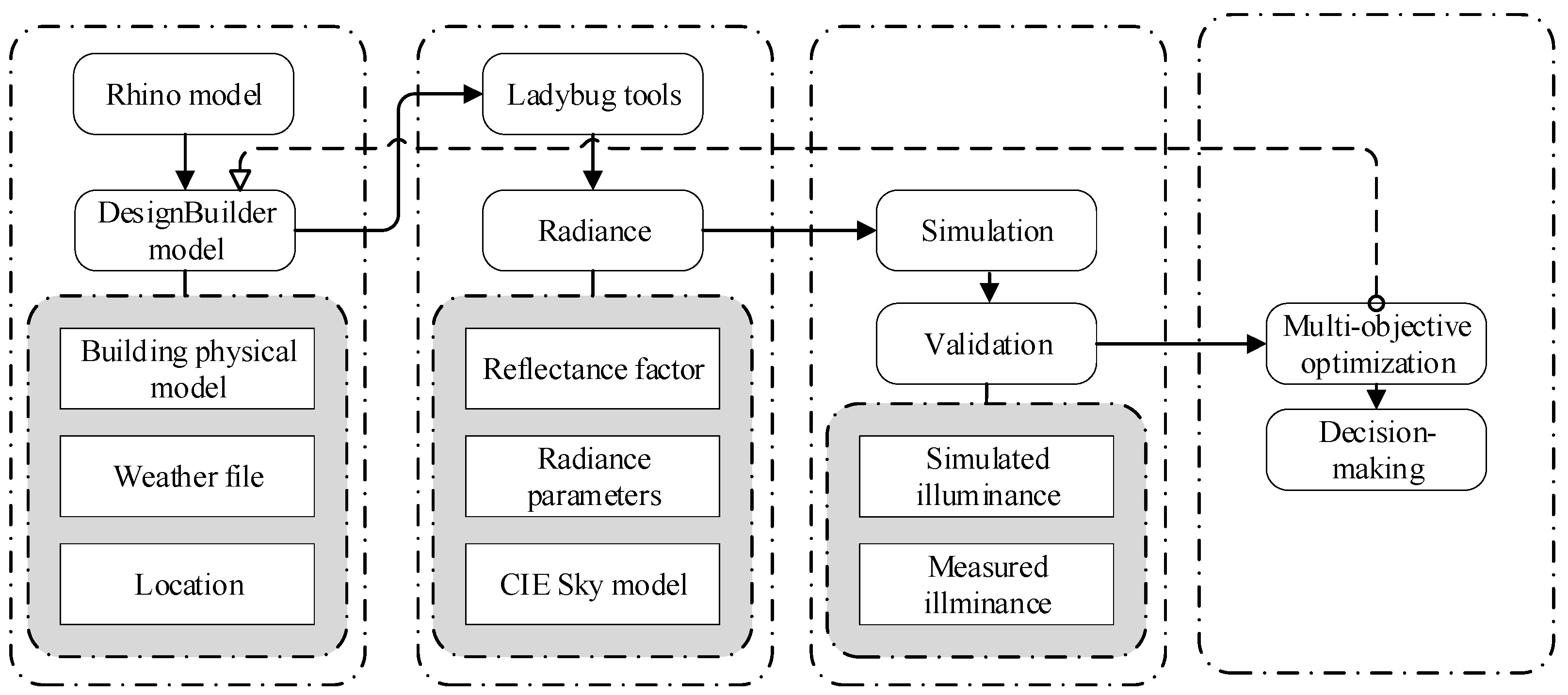
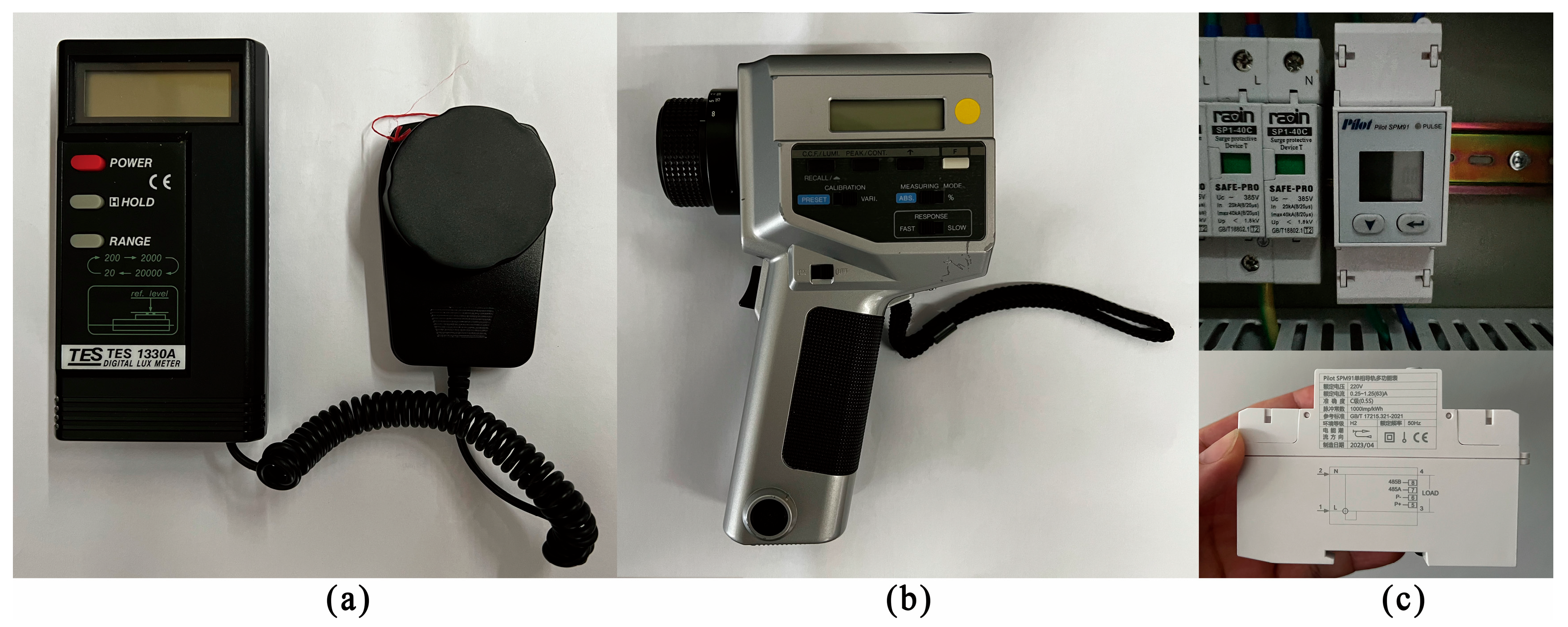
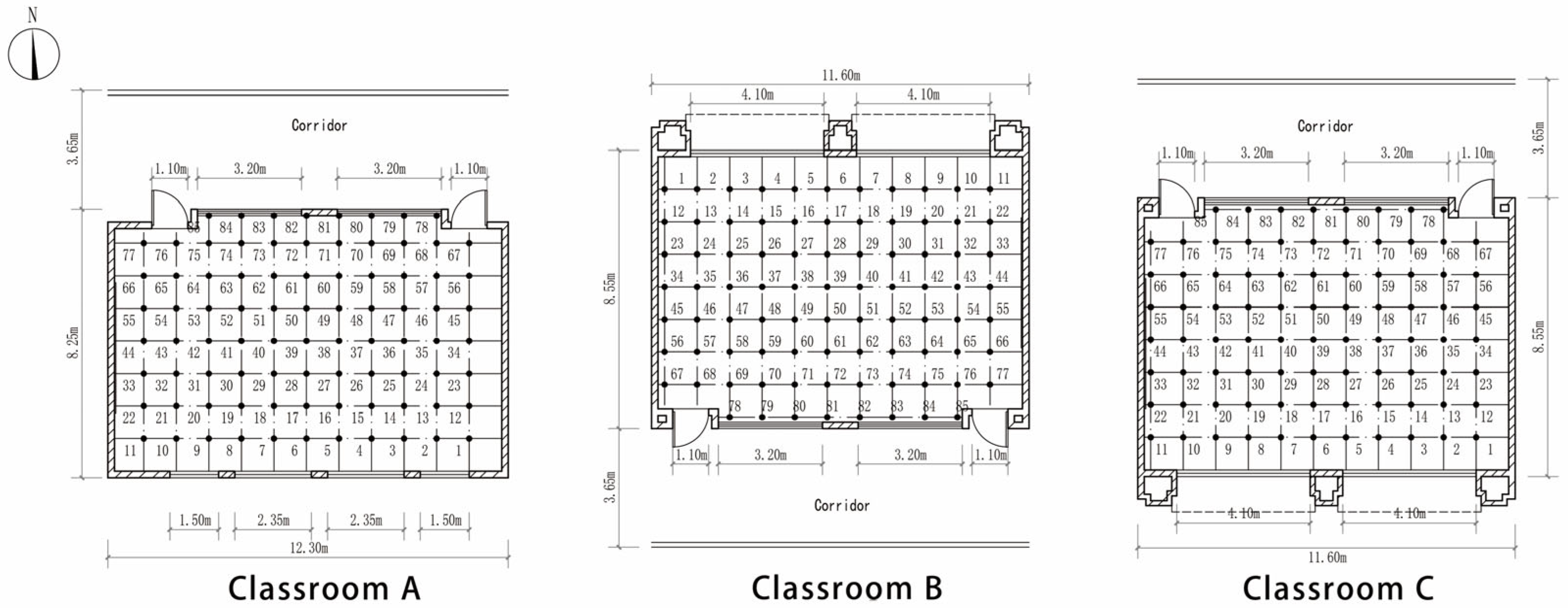



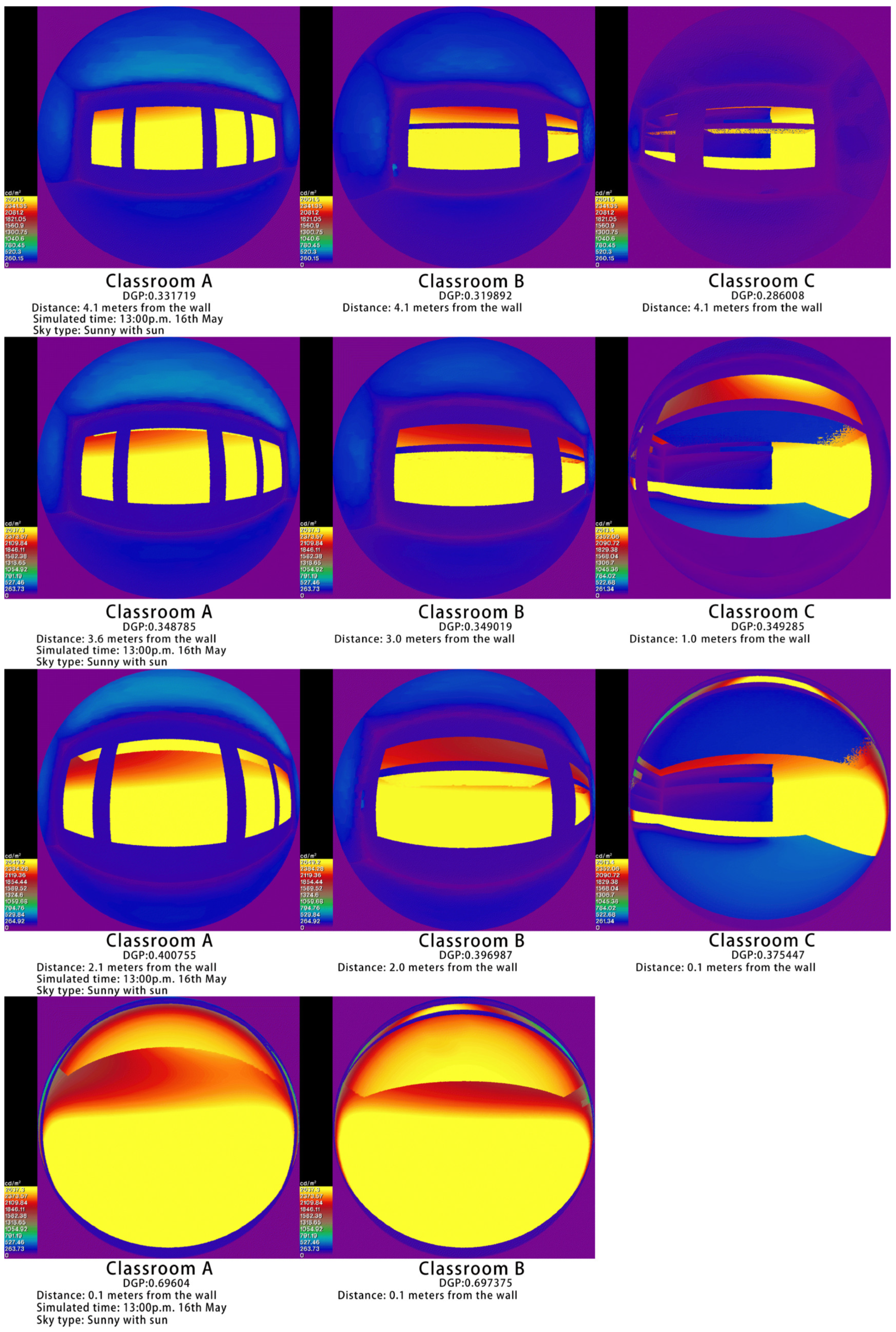
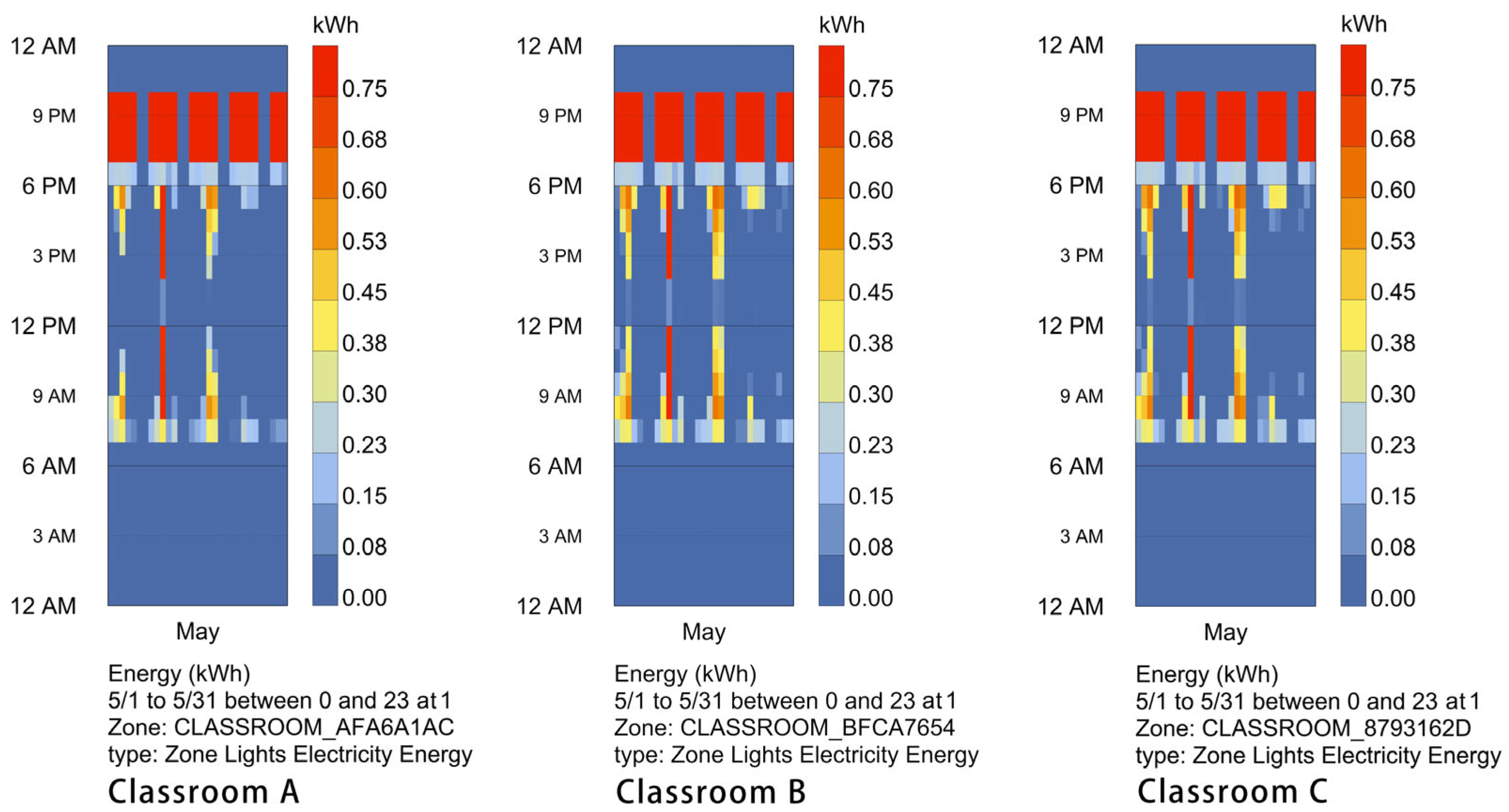
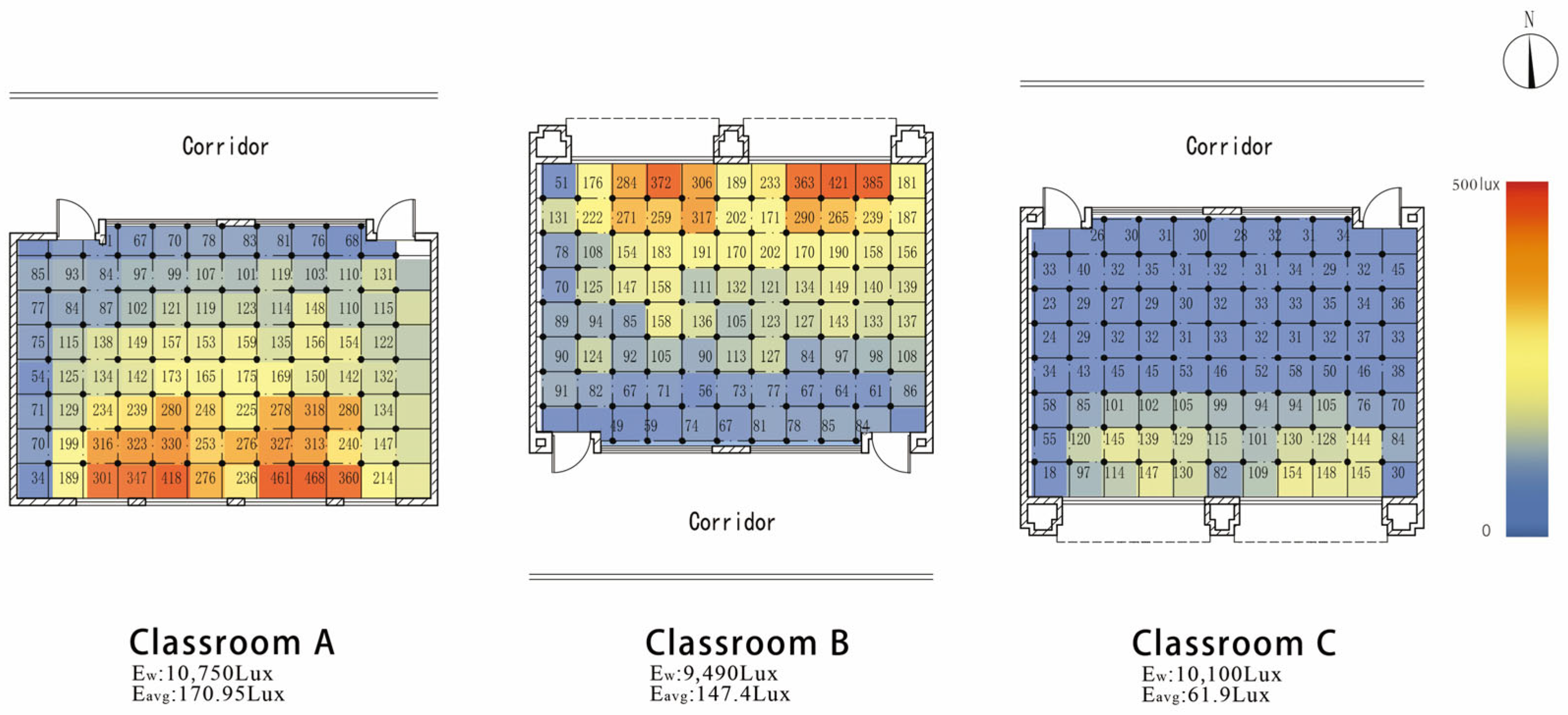

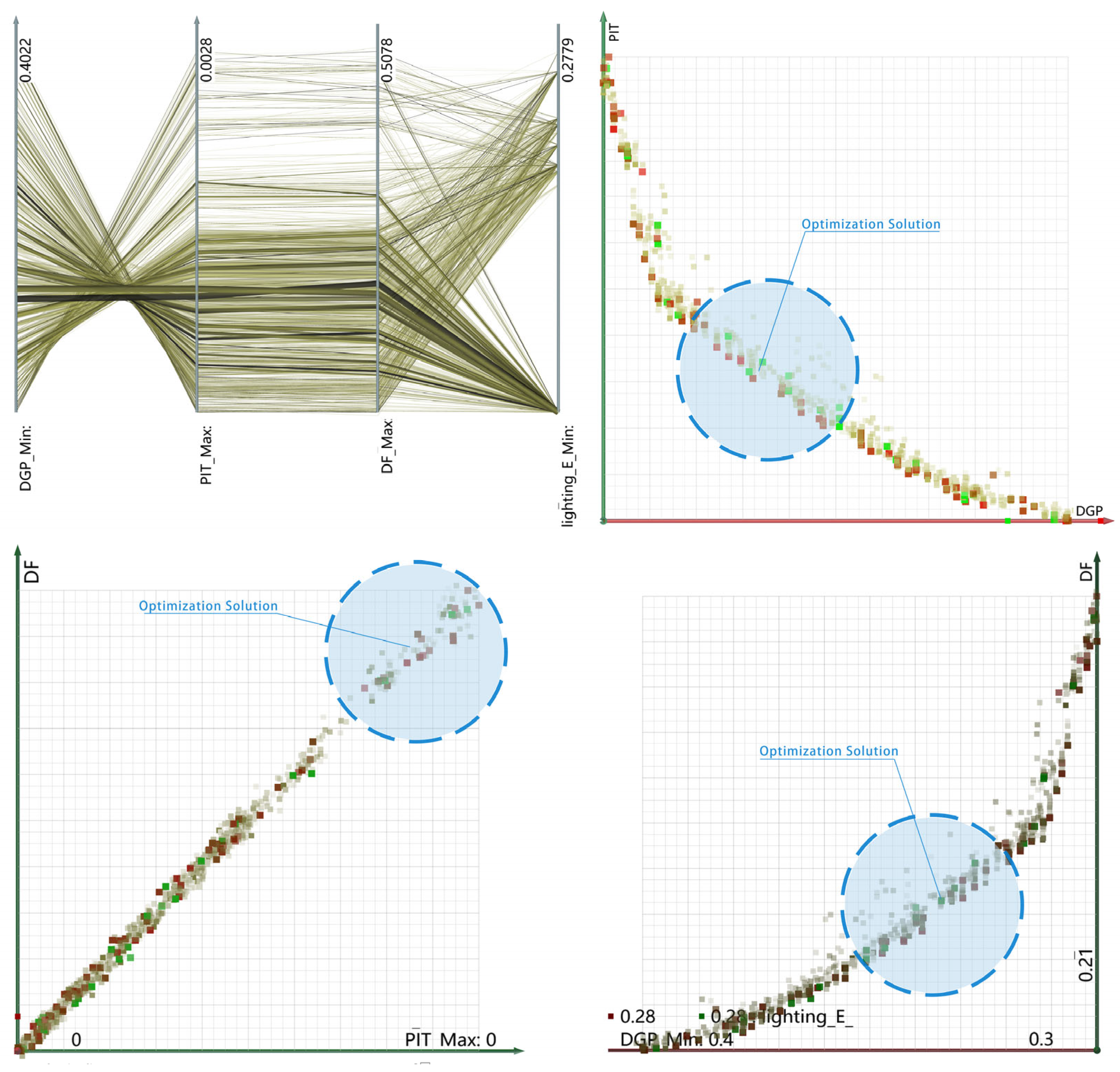
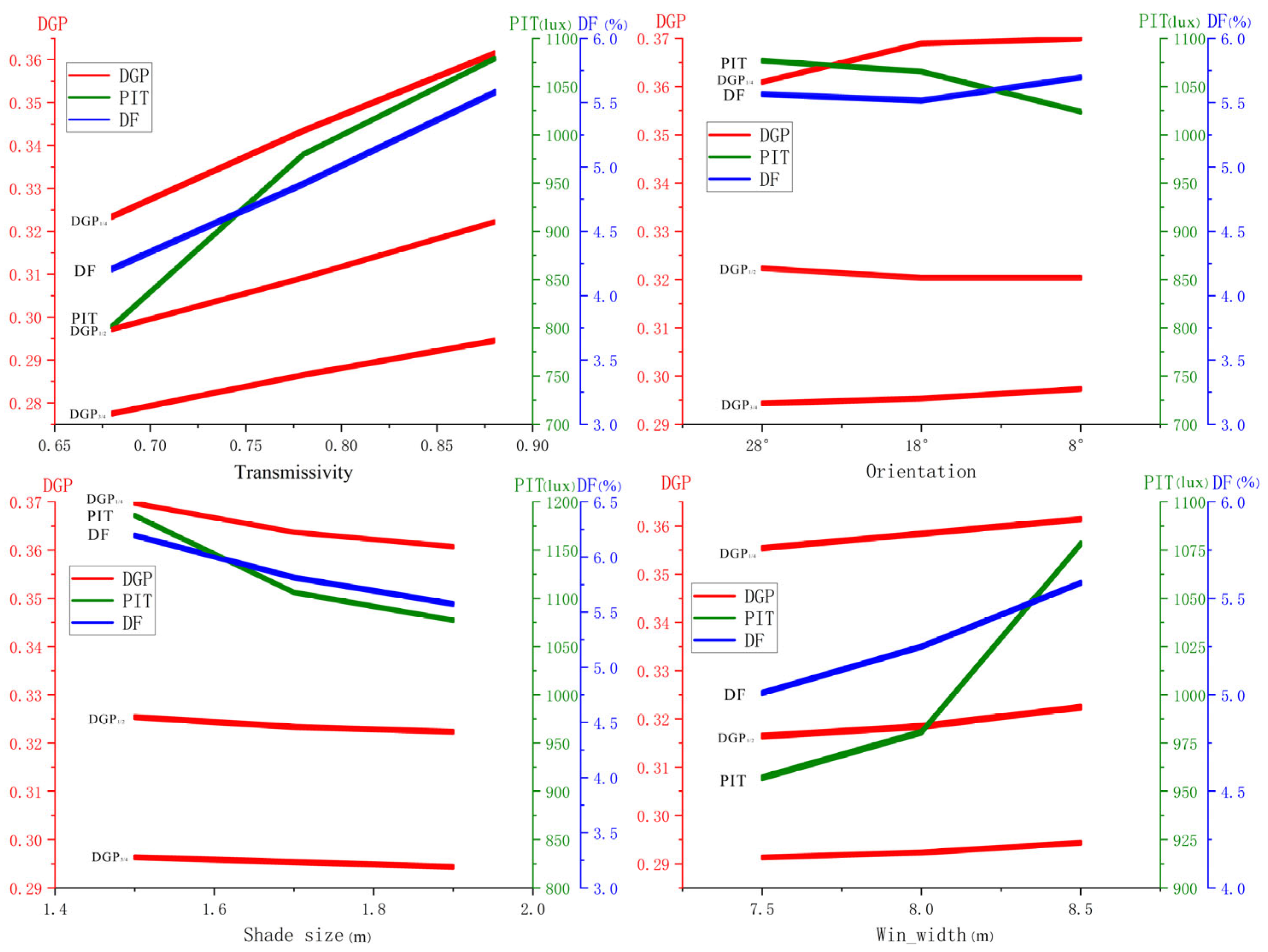
| Month | January | February | March | April | May | June | July | August | September | October | November | December |
|---|---|---|---|---|---|---|---|---|---|---|---|---|
| Sunshine duration (h) | 119 | 71.6 | 62.4 | 65.1 | 104 | 140 | 202 | 174 | 170 | 181 | 173 | 166 |
| Solar radiation (kWh/m2) | 85 | 67.5 | 74.4 | 83.6 | 108 | 116 | 141 | 136 | 123 | 122 | 105 | 93.1 |
| Orientation | Height (m) | Room Size (m) | Windows No. | Wall between Windows (m) | Shade Overhang Width (m) | Windows Transmittance | |
|---|---|---|---|---|---|---|---|
| Classroom A | S | 13.6 (45 ft) | 12.3 × 8.25 × 4 (40 × 27 × 13 ft) | 4 | 0.5 | Eave2.0 | 0.7 |
| Classroom B | N | 9.6 (31.5 ft) | 11.6 × 8.55 × 4 (38 × 28 × 13 ft) | 2 | 1.0 | 1.1 | 0.7 |
| Classroom C | S | 5.6 (18 ft) | 11.6 × 8.55 × 4 (38 × 28 × 13 ft) | 2 | 1.0 | 1.1 | 0.7 |
| TES1330A | Konica Minolta LS-110 | Pilot SPM91 | |
|---|---|---|---|
| Measuring range | 0.01–20,000 Lux | Fast: 0.01–999,900 cd/m2, Slow: 0.01–499,900 cd/m2 | 999,999.9 kWh |
| Accuracy | ±3%rdg ± 0.5%f.s | 0.01–9.99 cd/m2 ± 2% ± 2 value, >10.00 cd/m2 ± 2% ± 1 value | kWh Class 1.0 |
| Surface | ||||||||
|---|---|---|---|---|---|---|---|---|
| Ceiling | Wall (Whitewash) | Wall (Tile) | Floor | Window | Door | Shade | ||
| Reflectance factor | Standard | 0.7–0.8 | 0.5–0.6 | 0.5–0.6 | 0.2–0.4 | 0.2 | — | — |
| Measured | 0.79 | 0.75 | 0.68 | 0.4 | 0.2 | 0.49 | 0.71 | |
| Roughness | 0.05 | 0.05 | 0.05 | 0.05 | 1.5 | 0.05 | 0.1 | |
| Morning | Noon | Afternoon | Dusk | Night | |
|---|---|---|---|---|---|
| Time | 8:00–12:20 | 12:20–14:25 | 14:25–17:40 | 17:40–19:00 | 19:00–22:10 |
| Ls1/4 (cd/m2) | Ls1/2 (cd/m2) | Ls3/4 (cd/m2) | Eυ1/4 (lux) | Eυ1/2 (lux) | Eυ3/4 (lux) | DGP1/4 | DGP1/2 | DGP3/4 | |
|---|---|---|---|---|---|---|---|---|---|
| Classroom A | 9036.93 | 5415.31 | 4737.51 | 1989 | 1320 | 983 | 0.390 | 0.318 | 0.287 |
| Classroom B | 6536.13 | 3190.29 | 1427.17 | 1402 | 984 | 757 | 0.377 | 0.301 | 0.236 |
| Classroom C | 2036.54 | 1309.27 | 892.89 | 421 | 311 | 250 | 0.316 | 0.274 | 0.239 |
| May | Classroom A (kWh) | Classroom B (kWh) | Classroom C (kWh) |
|---|---|---|---|
| Lighting energy consumption | 83.96 | 97.33 | 118.86 |
| DGP1/4 | DGP1/2 | DGP3/4 | PITavg (lux) | DFavg (%) | Lighting Energy (kWh) | |
|---|---|---|---|---|---|---|
| Optimized solution | 0.361 | 0.322 | 0.294 | 1077.01 | 5.57 | 68.37 |
| Classroom A | 0.4 | 0.332 | 0.306 | 761.37 | 3.94 | 76.71 |
| Classroom B | 0.39 | 0.319 | 0.289 | 676.7 | 3.66 | 85.44 |
| Classroom C | 0.32 | 0.286 | 0.273 | 549.08 | 2.75 | 86.75 |
Disclaimer/Publisher’s Note: The statements, opinions and data contained in all publications are solely those of the individual author(s) and contributor(s) and not of MDPI and/or the editor(s). MDPI and/or the editor(s) disclaim responsibility for any injury to people or property resulting from any ideas, methods, instructions or products referred to in the content. |
© 2024 by the authors. Licensee MDPI, Basel, Switzerland. This article is an open access article distributed under the terms and conditions of the Creative Commons Attribution (CC BY) license (https://creativecommons.org/licenses/by/4.0/).
Share and Cite
Luo, J.; Yan, G.; Zhao, L.; Zhong, X.; Su, X. Evaluation of Design Parameters for Daylighting Performance in Secondary School Classrooms Based on Field Measurements and Physical Simulations: A Case Study of Secondary School Classrooms in Guangzhou. Buildings 2024, 14, 637. https://doi.org/10.3390/buildings14030637
Luo J, Yan G, Zhao L, Zhong X, Su X. Evaluation of Design Parameters for Daylighting Performance in Secondary School Classrooms Based on Field Measurements and Physical Simulations: A Case Study of Secondary School Classrooms in Guangzhou. Buildings. 2024; 14(3):637. https://doi.org/10.3390/buildings14030637
Chicago/Turabian StyleLuo, Jianhe, Gaoliang Yan, Lihua Zhao, Xue Zhong, and Xinyu Su. 2024. "Evaluation of Design Parameters for Daylighting Performance in Secondary School Classrooms Based on Field Measurements and Physical Simulations: A Case Study of Secondary School Classrooms in Guangzhou" Buildings 14, no. 3: 637. https://doi.org/10.3390/buildings14030637
APA StyleLuo, J., Yan, G., Zhao, L., Zhong, X., & Su, X. (2024). Evaluation of Design Parameters for Daylighting Performance in Secondary School Classrooms Based on Field Measurements and Physical Simulations: A Case Study of Secondary School Classrooms in Guangzhou. Buildings, 14(3), 637. https://doi.org/10.3390/buildings14030637





